Food Revolutions: Science and Nutrition, 1700-1950
Women, War, and Food
Food Conservation
Food conservation during WWI was voluntary and citizens were encouraged to abstain or reduce consumption from certain foods to save enough to be sent to the Allies and American soldiers abroad. Several campaigns were implemented such as Meatless Mondays and Wheatless Wednesdays to encourage food conservation. Other programs that were successful in both WWI and WWII were canning initiatives and Victory Gardens.
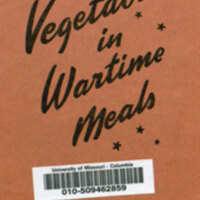
Root vegetables in wartime meals.
[Washington, D.C.] : U.S. Dept. of Agriculture, [1943]
A 1.59:39
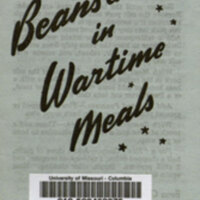
United States. Bureau of Human Nutrition and Home Economics.
Dried beans & peas in wartime meals
Washington, D.C. : U.S. G.P.O., [1943]
A 1.59:47
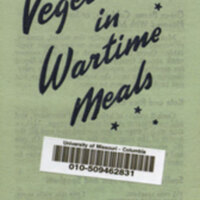
Green vegetables in wartime meals.
[Washington, D.C.] : U.S. Dept. of Agriculture, [1943]
A 1.59:54
Cooking Guides
During World War II, rationing was mandatory in the United States. Items rationed included oil, rubber, silk, and many different foods such as wheat, meat, and sugar. Women, as the primary homemakers, were faced with balancing nutrition and ration points to create a healthy diet for their families. Attempting to cook a balanced meal without many staples could be challenging. To educate and support women, many cookbooks were created which included meal planning, management of ration points, and satisfying the family's nutritional needs.
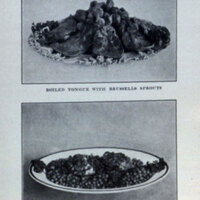
Mary Elizabeth's War Time Recipes (New York, Frederick A. Stokes company [c1918])
TX715 .M378 1918
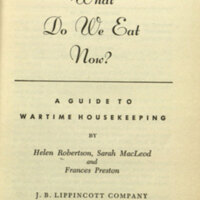
Helen Robertson, Sarah MacLeod and Frances Preston
What do we eat now? A guide to wartime housekeeping (Philadelphia, Lippincott [1942])
641.5 R546w

Gertrude Voellmig
Wartime Cooking Guide: Stretching the Points (Chicago, Reilly & Lee [1943])
641.5 V857w

Mary Lippincott Richards Taylor (b. 1874)
Economy for Epicures, a practical menu and recipe book (New York, London [etc.] Oxford university press, c1943.)
641.5 T216e
Victory Gardens
Food conservation during World War I and II was critical to victory. Women were encouraged to plant "Victory Gardens" in their own yards and in community plots of land. Victory Gardens consisted of fruits, vegetables, and herbs to supplement food purchased in local stores. War gardening also offered an opportunity to offset the drain on commercial supplies and enabled more food to be sent abroad. During World War II, it is estimated by the U.S.D.A. that over 20 million gardens were planted and over 9 million tons of extra food were produced.
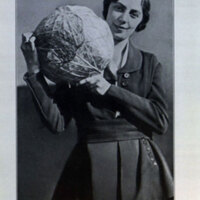
Charles Lathrop Pack (1857-1937)
The War Garden Victorious (Philadelphia, J.P. Lippincott Company [1919])
632.2 P12
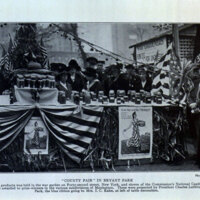
Charles Lathrop Pack (1857-1937)
The War Garden Victorious (Philadelphia, J.P. Lippincott Company [1919])
632.2 P12
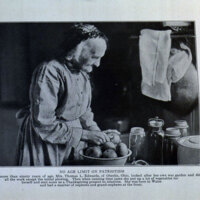
Charles Lathrop Pack (1857-1937)
The War Garden Victorious (Philadelphia, J.P. Lippincott Company [1919])
632.2 P12
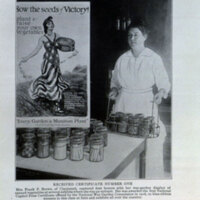
Charles Lathrop Pack (1857-1937)
The War Garden Victorious (Philadelphia, J.P. Lippincott Company [1919])
632.2 P12
Women’s Land Army
Women were not only encouraged to plant Victory Gardens, but to volunteer time on farms to increase food production. The Women's Land Army was a civilian group that served as emergency farmers to replace men who were sent off to war in both WWI and WWII. It is estimated over 250,000 women participated in the program in 1943 alone.
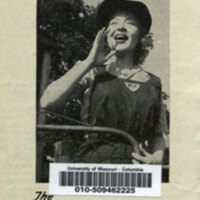
Pitch in and help! The Women's Land Army calls 800,000 to the farm in 1944.
[Washington, D.C.] : U.S. Dept. of Agriculture, [1944]
MU Libraries Federal Government Documents Collection
A 1.59:101

United States. Extension Service.
Women's Land Army of the U.S. Crop Corps needs workers
[Washington, D.C. : U.S. G.P.O., 1943]
MU Libraries Federal Government Documents Collection
A 1.59:50
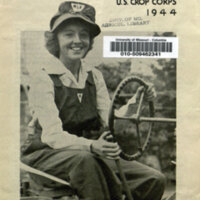
United States. War Food Administration.
The Women's Land Army of the U.S. Crop Corps, 1944
[Washington, D.C. : U.S. G.P.O., 1944]
MU Libraries Federal Government Documents Collection
A 1.59:102
Canning
As part of the Victory Garden campaign, women were encouraged to can food that was grown at home. Canning, which is the process of sealing food in cans, tins, or jars, for preservation, was essential so no good food went to waste. In 1917, women preserved over 500,000,000 quart jars of garden produce and by 1918, had stored 1,450,000,000 quart jars.

Wartime canning of fruits, vegetables.
Washington, D.C. : Bureau of Human Nutrition and Home Economics, Agricultural Research Administration, U.S. Dept. of of Agriculture, [1943]
MU Libraries Federal Government Documents Collection
A 1.59:41
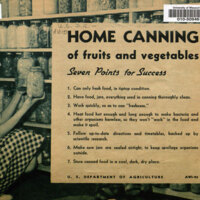
United States. Bureau of Human Nutrition and Home Economics.
Home Canning of Fruits and Vegetables - Seven Points For Success.
MU Libraries Federal Government Documents Collection
A 1.59:93
Basic 7
Keeping the family healthy was considered a patriotic duty during wartime and women were encouraged to feed their families the "Basic 7" everyday. The USDA created the Basic 7 nutritional chart for recommended food groups during WWII to help citizens adapt to food shortages.
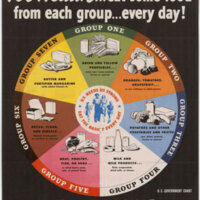
For health--eat some food from each group--every day! [graphic].
[Washington] : U.S. Dept. of Agriculture, 1943.
D743.25 .F669 1943
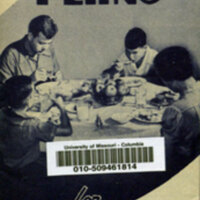
United States. Bureau of Human Nutrition and Home Economics.
Family food plans for good nutrition
[Washington, D.C. : U.S. G.P.O., 1943]
A 1.59:78

United States. Bureau of Human Nutrition and Home Economics.
Eat a good breakfast-- to start a good day
[Washington, D.C. : U.S. G.P.O., 1944]
A 1.59:107